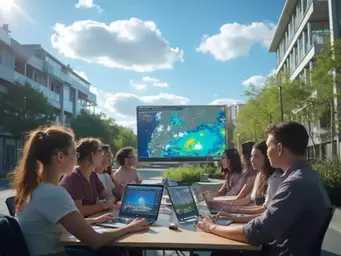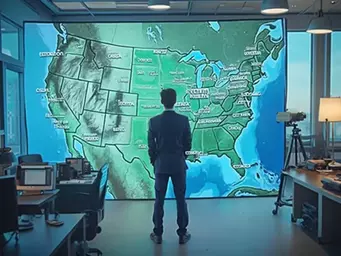As you ponder your future in meteorology, consider this: the right qualification can make all the difference in shaping your career. How do you choose the path that's best for you? In this guide, we will uncover the essential aspects to consider when selecting a qualification in meteorology in Australia.
What You Will Learn
- Different qualifications in meteorology are available in Australia, ranging from diplomas to bachelor's degrees.
- Your career aspirations should guide your choice of qualification, whether it's research, forecasting, or emergency management.
- A Bachelor’s degree offers a more comprehensive education compared to a Graduate Diploma, which focuses on specialized knowledge.
- Networking opportunities through degree programs can significantly enhance your employability in the field.
- The entry requirements for Graduate Diplomas are generally higher than for Bachelor's degrees, often requiring a related undergraduate degree.
- Both qualifications lead to promising career paths, but job roles may differ significantly based on the depth of study.
- Having a qualification recognized by the World Meteorological Organization (WMO) enhances your professional credibility globally.
- Understanding the Australian Qualifications Framework (AQF) aids in comparing the level of education across different qualifications.
Comparing Meteorology Qualifications: Graduate Diploma vs. Bachelor's Degree
This visual highlights the key distinctions between a Graduate Diploma and a Bachelor's Degree in Meteorology, focusing on duration, entry requirements, career paths, and AQF levels. Understanding these differences is crucial for aspiring meteorologists to choose the right educational path for their career goals.
The Graduate Diploma
- ✓ Duration: 1 year full-time
- ✓ Entry: Bachelor's in related science (e.g., physics)
- ✓ AQF Level: 8 (Advanced knowledge)
- ✓ Career Paths: Technician, Data Analyst, Environmental Monitoring Specialist. Often quicker entry to specialized roles.
The Bachelor's Degree
- ✓ Duration: 3 years full-time
- ✓ Entry: High school (strong math/science)
- ✓ AQF Level: 7 (Foundational education)
- ✓ Career Paths: Weather Forecasting, Research, Managerial Roles. Broader options and deeper scientific understanding.
Industry Recognition & Next Steps
WMO Recognition: Certain Graduate Diplomas are recognized by the World Meteorological Organization, enhancing global credibility.
Recommendation: Evaluate current qualifications, research programs, connect with professionals, and prepare applications. Consider financial aspects.
Understanding Meteorology Qualifications in Australia
Choosing the right qualification in meteorology is vital for anyone looking to build a successful career in this exciting field. As someone who has dedicated years to understanding the intricacies of weather science, I can attest to the importance of selecting an educational path that aligns with your goals. A well-chosen qualification not only sets the stage for your technical skills but also enhances your credibility and employability in a competitive job market!
In Australia, aspiring meteorologists have a range of qualifications to consider, from diplomas to bachelor's degrees. The decision can significantly affect your career trajectory, so it’s crucial to take the time to weigh your options carefully. Let’s dive into the details of how to make this important choice!
The Importance of Choosing the Right Qualification
When it comes to meteorology, the right qualification can open doors to a plethora of opportunities. Each educational pathway offers distinct advantages, shaping your expertise in specific areas of weather science. Here are some factors to consider when making your decision:
- Career Aspirations: Think about where you see yourself in the future. Do you want to work in research, forecasting, or perhaps in emergency management? Your chosen qualification should align with these aspirations.
- Depth of Knowledge: A Bachelor's degree typically offers a broader and more in-depth education compared to a Graduate Diploma, which may focus on advanced topics suited for those already holding an undergraduate degree. To learn more about the differences between degrees and diplomas, you can refer to this helpful guide on diplomas vs. degrees.
- Networking Opportunities: Degree programs often provide invaluable connections through internships and collaborations, helping you build relationships with professionals in the field.
By carefully weighing these factors, you can make an informed choice that sets you on the right path. It’s exciting to think about the possibilities—a well-chosen qualification can lead to a fulfilling career affecting our understanding of weather and climate!
Comparing the Graduate Diploma and Bachelor’s in Meteorology
Course Structure and Duration Overview
Let’s take a closer look at the structure and duration of the Graduate Diploma in Meteorology compared to a Bachelor’s degree. Understanding these differences is key to choosing the program that best suits your needs.
- Graduate Diploma: Typically lasts 1 year full-time and focuses on specialized knowledge and skills in meteorology.
- Bachelor’s Degree: Usually spans 3 years full-time, providing a comprehensive foundation in atmospheric sciences along with broader studies in related fields.
The Graduate Diploma is ideal for those seeking to deepen their expertise quickly, while a Bachelor’s degree lays the groundwork for a more extensive range of career options. It’s essential to consider how much time you can commit to your studies and your long-term career goals when choosing between these paths! For further reading on the distinct characteristics of different academic credentials, explore the differences between diplomas and degrees.
Entry Requirements for Both Programs
Understanding the entry requirements for each program can help you better prepare for your journey into meteorology. Here’s what you need to know:
- Graduate Diploma: Generally requires a Bachelor’s degree in a related science field, such as environmental science or physics.
- Bachelor’s Degree: Requires completion of high school with strong results in mathematics and science subjects, plus potential additional prerequisites depending on the university.
Make sure to review specific university requirements, as these can vary widely. By understanding these prerequisites, you can better plan your educational journey!
Career Pathways and Job Outlook
Both the Graduate Diploma and Bachelor’s degree can lead to rewarding careers in meteorology, but they may offer different pathways. Let’s explore what’s available!
- Graduate Diploma Graduates: Often step into roles such as meteorological technicians, data analysts, or specialists in environmental monitoring.
- Bachelor’s Degree Graduates: Typically have access to broader roles, including weather forecasting, research positions, and even managerial roles within meteorological agencies.
The demand for meteorologists is on the rise due to increasing awareness of climate change and its impacts. With either qualification, graduates can expect a strong job outlook, but the specific career trajectory may differ based on the depth of study!
Industry Recognition and Professional Credibility
One critical factor to consider is the industry recognition associated with your qualification. The World Meteorological Organization (WMO) recognizes certain Graduate Diplomas, which can enhance your credibility in the field. This recognition signifies that the program meets international standards, making graduates more appealing to employers!
Having a qualification recognized by WMO can open doors globally, allowing you to work in various meteorological roles around the world. It’s a crucial aspect to factor into your decision-making process when choosing your educational path.
Understanding the Australian Qualifications Framework (AQF)
The Australian Qualifications Framework (AQF) plays an important role in comparing educational qualifications throughout Australia. For meteorology, it sets the standard for what constitutes a recognized qualification.
- Graduate Diploma: Typically positioned at Level 8 of the AQF, indicating advanced knowledge and skills.
- Bachelor’s Degree: Generally categorized at Level 7 of the AQF, reflecting a foundational level of education.
Understanding the AQF can help you navigate your options effectively. This framework provides clarity on the level of education and expertise you can expect from each qualification. For a detailed comparison of academic certifications, including diplomas and degrees, consider reading this overview on certificates, diplomas, and degrees.
Frequently Asked Questions (FAQs)
Engage with Us!
As you consider your educational journey in meteorology, we want to hear from you! What factors are most important to you when choosing a qualification? Is it the duration, depth of knowledge, or career prospects? Share your thoughts below:
Summarizing Key Differences and Recommendations
When it comes to pursuing a career in meteorology, understanding the differences between a Graduate Diploma and a Bachelor's in Meteorology is crucial. Each qualification has unique features that cater to different career aspirations and educational goals.
For instance, if you’re looking to enter the workforce quickly, a Graduate Diploma may be your best bet. However, if you aim for a deeper understanding of meteorology and wish to explore research opportunities, a Bachelor's degree could be more suitable. Here are some key distinctions to consider:
- Duration: Graduate Diplomas typically require less time to complete, often around one year, whereas Bachelor's degrees usually take three to four years.
- Depth of Knowledge: Bachelor's programs offer a comprehensive study of meteorology, including theoretical and practical components, while Graduate Diplomas focus on applied skills.
- Career Prospects: A Bachelor's degree may open more doors in terms of advanced roles and positions within government and research institutions.
- Research Opportunities: Bachelor’s students often have greater access to research projects and funding, enhancing their career trajectory.
With these considerations, reflect on what aligns most closely with your career aspirations. Are you eager to enter the workforce quickly, or are you looking to delve deeper into the science of weather? Identifying your goals will guide you toward the right qualification.
Next Steps for Aspiring Meteorologists
As you embark on your journey in meteorology, it’s essential to take actionable steps toward achieving your goals. Start by evaluating your current qualifications and determining which program aligns best with your aspirations. Here’s a straightforward plan to help you move forward:
- Research Programs: Explore universities offering Graduate Diplomas and Bachelor's degrees in meteorology. Look for course structures that excite you!
- Connect with Professionals: Reach out to meteorologists, including those featured on the Meteorologist Career Guide. Their insights can guide you in making informed decisions.
- Prepare Your Application: Gather necessary documentation, such as academic transcripts and any prerequisites needed for enrollment.
- Consider Financial Aspects: Look into tuition fees, scholarships, and potential financial aid options to make your education more affordable.
By taking these steps, you’ll be well on your way to carving out your path in the exciting world of meteorology! Remember, I’m here to support you through this journey, helping you gain the knowledge and skills needed for a fulfilling career.
Recap of Key Points
Here is a quick recap of the important points discussed in the article:
- Choose the Right Qualification: Align your educational path with your career aspirations, whether in research, forecasting, or emergency management.
- Understand Course Structures: A Graduate Diploma typically takes 1 year and focuses on specialized knowledge, while a Bachelor's degree lasts 3 years and provides a comprehensive education.
- Know Entry Requirements: Graduate Diplomas require a related Bachelor's degree, whereas Bachelor's programs need strong high school results in mathematics and science.
- Career Pathways: Graduates from a Bachelor's program have access to broader roles, including research and management positions.
- Industry Recognition: Qualifications recognized by the World Meteorological Organization (WMO) enhance credibility and employability.
- Utilize the AQF: Familiarize yourself with the Australian Qualifications Framework to understand the level of education associated with each qualification.
- Next Steps: Research programs, connect with professionals, prepare your application, and consider financial aspects to ensure a smooth educational journey.










